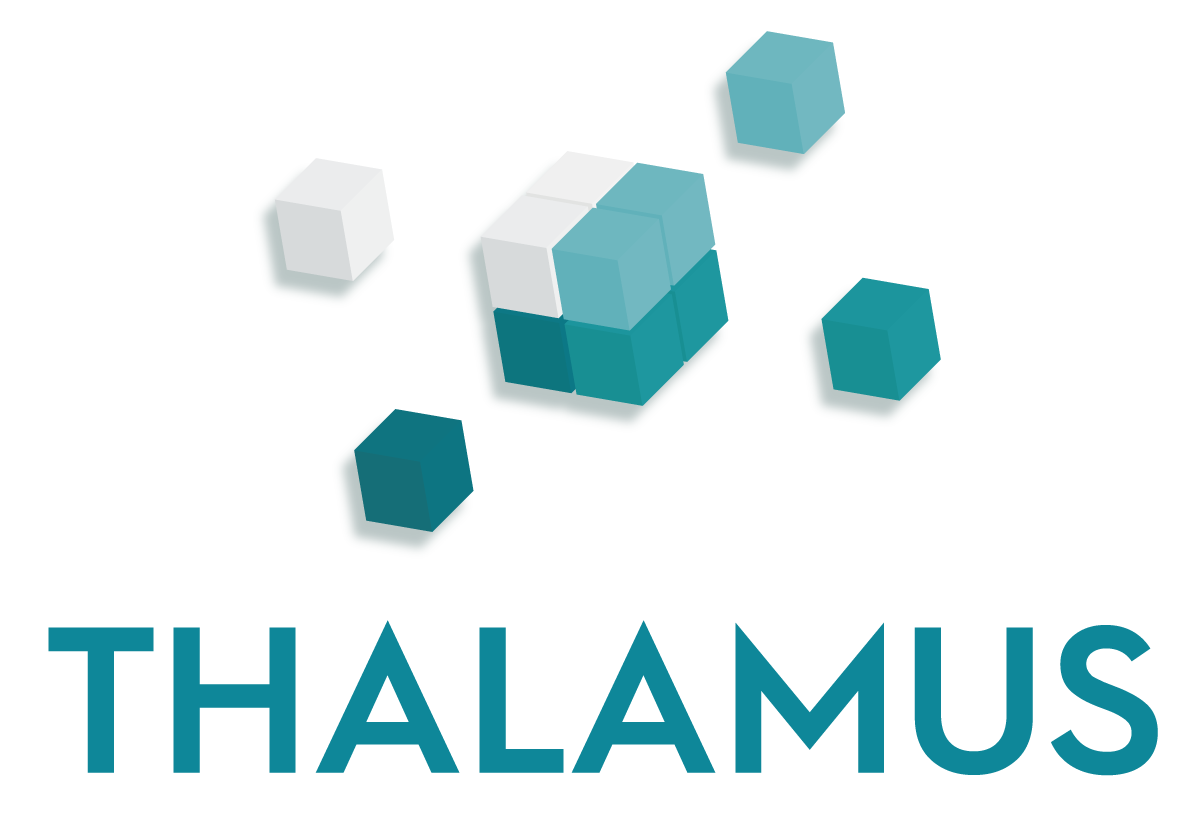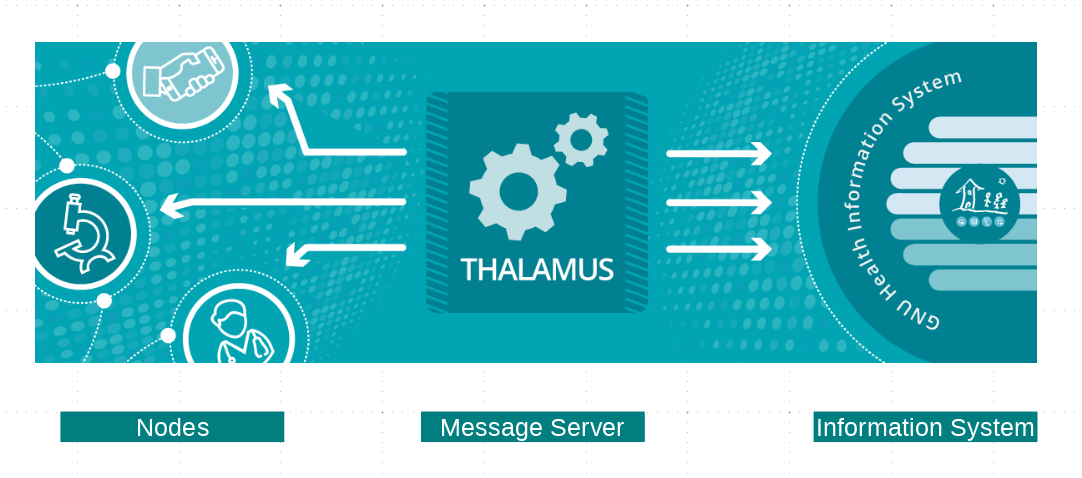
The GNU Health Message and Authentication Server
Note
This document is licensed under Creative Commons Attribution-ShareAlike 4.0 International (CC BY-SA 4.0)
| Author: | Luis Falcon |
|---|---|
| Contact: | info@gnuhealth.org |
| Version: | 0.9.16 |
Introduction
The Thalamus project provides a RESTful API hub to all the GNU Health Federation nodes. The main functions are:
- Message server: A concentrator and message relay from and to the participating nodes in the GNU Health Federation and the GNU Health Information System (PgSQL). Some of the participating nodes include the GNU Health HMIS, MyGNUHealth mobile PHR application, laboratories, research institutions and civil offices.
- Authentication Server: Thalamus also serves as an authentication and authorization server to interact with the GNUHealth Information System
Thalamus is part of the GNU Health project, but it is a self contained, independent server that can be used in different health related scenarios.

Technology
RESTful API: Thalamus uses a REST (Representional State Transfer) architectural style, powered by Flask technology
Thalamus will perform CRUD (Create, Read, Update, Delete) operations. They will be achieved via the following methods upon resources and their instances.
- GET : Read
- POST : Create
- PATCH : Update
- DELETE : Delete.
The DELETE operations will be minimal.
JSON: The information will be encoded in JSON format.
Resources
Some resources and end-points are:
- People (/people)
- Pages of Life (/pols)
- DomiciliaryUnits (/domiciliary-units)
- PersonalDocs (/personal_docs)
Installation
Create a new user thalamus with PostgreSQL permissions
Install PostgreSQL and create an operating system user called thalamus
Locate the pg_hba.conf file and add the following line:
local all all trust
If you don't find the file refer to 'Verify PostgreSQL authentication method' in the HMIS node installation guide.
Restart PostgreSQL:
$ sudo systemctl restart postgresql.service
Give permissions to the newly created thalamus user:
$ sudo su - postgres -c "createuser --createdb --no-createrole --no-superuser thalamus"
Installing Thalamus
Thalamus is a flask application, and is pip installable. Using the thalamus operating system user, install Thalamus server locally:
$ pip3 install --user wheel $ pip3 install --user thalamus $ pip3 install --user flask-cors
Initializing PostgreSQL for the HIS and Person Master Index
The following documentation applies to a demo / test database, that we will call "federation"
Create the database:
$ createdb federation
Locate thalamus:
$ pip3 show thalamus $ cd /path/thalamus/demo/
#. Create the Federation HIS schema. Inside the "demo" directory in Thalamus execute the following SQL script:
$ psql -d federation < federation_schema.sql
#. Set the PostgreSQL URI for demo data: In import_pg.py adjust the variable PG_URI to fit your needs. It could be sufficient to just put "dbname='federation'" into psycopg2.connect(...) if your setup fits the default settings.
Initialize the Federation Demo database:
$ bash ./populate.sh
#. Set the PostgreSQL URI for runtime: Just like in the second step modify POSTGRESQL_URI in etc/thalamus.cfg
At this point you can run and test Thalamus directly from the Flask Werkzeug server:
$ python3 ./thalamus.py
This is ok for development and testing environments, but for production sites, always run Thalamus from a WSGI container, as described in the next section.
Running Thalamus from a WSGI Container
In production settings, for performance reasons you should use a HTTP server. We have chosen uWSGI , but you can use any WSGI server. We have also included the configuration file for Gunicorn if you prefer it instead of uWSGI.
Running Thalamus from uWSGI
We have included a uwsgi sample configuration file (etc/thalamus_uwsgi.ini). In order to test uWSGI with HTTP it should look like this:
[uwsgi] master = 1 # https = 0.0.0.0:8443, /opt/gnuhealth/certs/gnuhealthfed.crt,/opt/gnuhealth/certs/gnuhealthfed.key http = 0.0.0.0:8080 wsgi-file = thalamus.py callable = app processes = 4 threads = 2 block-size = 32000 stats = 127.0.0.1:9191 plugins = http,python
To execute Thalamus with the default configuration file:
$ uwsgi --ini etc/thalamus_uwsgi.ini
All these arguments can also be passed to the command line.
Enable SSL for encrypted communication
Either get an official certificate or generate a self-signed certificate and private key:
$ sudo openssl req -newkey rsa:2048 -new -x509 -days 3650 -nodes -out gnuhealthfed.crt -keyout gnuhealthfed.key
If uWSGI should handle HTTPS, place the certificate (gnuhealthfed.crt) and private key (gnuhealthfed.key) in a directory where the thalamus user has read permissions. Afterwards change etc/thalamus_uwsgi from HTTP to HTTPS using the correct paths. Keep a backup of them in a safe place. Alternatively keep uWSGI as internal HTTP server and configure a HTTPS reverse proxy. Using apache2 you can create a file thalamus.conf as site with the following content:
<IfModule mod_ssl.c>
<VirtualHost *:443>
SSLEngine on
SSLCertificateFile /etc/ssl/certs/gnuhealthfed.crt
SSLCertificateKeyFile /etc/ssl/private/gnuhealthfed.key
ServerName domain
ProxyPass / http://your_host:8080/
ProxyPassReverse / http://your_host:8080/
</VirtualHost>
</IfModule>
Depending on the operating system place this inside /etc/apache2/vhosts.d/ (openSUSE) or /etc/apache2/sites-available/ (Debian/Ubuntu). For the last case enable it afterwards using the a2ensite command. Finally enable some modules and restart apache:
$ sudo a2enmod headers ssl proxy proxy_http $ sudo systemctl restart apache2.service
Create a systemd service
In order to control Thalamus with systemctl and enable it to be activated after startup create a service file thalamus.service with the following content:
[Unit] Description=Thalamus Server After=network.target [Service] User=gnuhealth WorkingDirectory=/home/gnuhealth/.local/lib/python3.9/site-packages/thalamus ExecStart=uwsgi --ini etc/thalamus_uwsgi.ini Restart=on-abort Type=notify KillSignal=SIGQUIT StandardError=syslog [Install] WantedBy=multi-user.target
Note
Replace the value of the WorkingDirectory to fit your needs.
Put this in the appropriate directory for your operating system: For example /etc/systemd/system/ on Debian/Ubuntu and openSUSE. Afterwards start and enable the service:
$ sudo systemctl start thalamus.service $ sudo systemctl enable thalamus.service
Using a virtual environment
If you want to use a virtual environment create and activate the virtual environment before installing Thalamus:
$ python3 -m venv /home/thalamus/venv $ source /home/thalamus/venv/bin/activate
Besides add the following line to etc/thalamus_uwsgi.ini:
venv = /home/thalamus/venv/
Examples
Command-line, using httpie
Retrieve the demographic information of person:
$ http --verify no --auth ITAPYT999HON:gnusolidario https://localhost:8443/people/ESPGNU777ORG
Yields to:
HTTP/1.1 200 OK
Connection: close
Content-Length: 411
Content-Type: application/json
Date: Fri, 21 Apr 2017 16:22:38 GMT
Server: gunicorn/19.7.1
{
"_id": "ESPGNU777ORG",
"active": true,
"biological_sex": "female",
"dob": "Fri, 04 Oct 1985 13:05:00 GMT",
"education": "tertiary",
"ethnicity": "latino",
"gender": "female",
"lastname": "Betz",
"marital_status": "married",
"name": "Ana",
"password": "$2b$12$cjrKVGYEKUwCmVDCtEnwcegcrmECTmeBz526AAD/ZqMGPWFpHJ4FW",
"profession": "teacher",
"roles": [
"end_user"
]
}
Retrieve the demographics information globally:
$ http --verify no --auth ITAPYT999HON:gnusolidario https://localhost:8443/people
Yields to:
HTTP/1.1 200 OK
Connection: close
Content-Length: 933
Content-Type: application/json
Date: Fri, 21 Apr 2017 16:31:23 GMT
Server: gunicorn/19.7.1
[
{
"_id": "ITAPYT999HON",
"active": true,
"biological_sex": "female",
"dob": "Fri, 05 Oct 1984 09:00:00 GMT",
"education": "tertiary",
"ethnicity": "latino",
"gender": "female",
"lastname": "Cordara",
"marital_status": "married",
"name": "Cameron",
"password": "$2b$12$Y9rX7PoTHRXhTO1H78Tan.8mVmyayGAUIveiYxu2Qeo0ZDRvJQ8/2",
"profession": "teacher",
"roles": [
"end_user",
"health_professional"
]
},
{
"_id": "ESPGNU777ORG",
"active": true,
"biological_sex": "female",
"dob": "Fri, 04 Oct 1985 13:05:00 GMT",
"education": "tertiary",
"ethnicity": "latino",
"gender": "female",
"lastname": "Betz",
"marital_status": "married",
"name": "Ana",
"password": "$2b$12$cjrKVGYEKUwCmVDCtEnwcegcrmECTmeBz526AAD/ZqMGPWFpHJ4FW",
"profession": "teacher",
"roles": [
"end_user"
]
}
]
Using Python requests:
>>> import requests
>>> person = requests.get('https://localhost:8443/people/ESPGNU777ORG', auth=('ITAPYT999HON', 'gnusolidario'), verify=False)
>>> person.json()
{'_id': 'ESPGNU777ORG', 'active': True, 'biological_sex': 'female','dob': 'Fri, 04 Oct 1985 13:05:00 GMT',
'education': 'tertiary', 'ethnicity': 'latino', 'gender': 'female', 'lastname': 'Betz', 'marital_status': 'married',
'name': 'Ana', 'password': '$2b$12$cjrKVGYEKUwCmVDCtEnwcegcrmECTmeBz526AAD/ZqMGPWFpHJ4FW', 'profession': 'teacher',
'roles': ['end_user']}
Note on roles The demo user "ITAPYT999HON" is a health professional (health_professional role), so she has global access to demographic information.
The user "ARGBUE111FAV" with the password "freedom" is the "root" user for thedemo database.
Check the roles.cfg file for examples information about roles and ACLs.
Development
Thalamus is part of the GNU Health project.
The development will be done on GNU Savannah, using the Mercurial repository.
Tasks, bugs and mailing lists will be on health-dev@gnu.org , for development.
General questions can be done on health@gnu.org mailing list.
Release Cycle
Thalamus, as other GNU Health components, will follow its own release process.